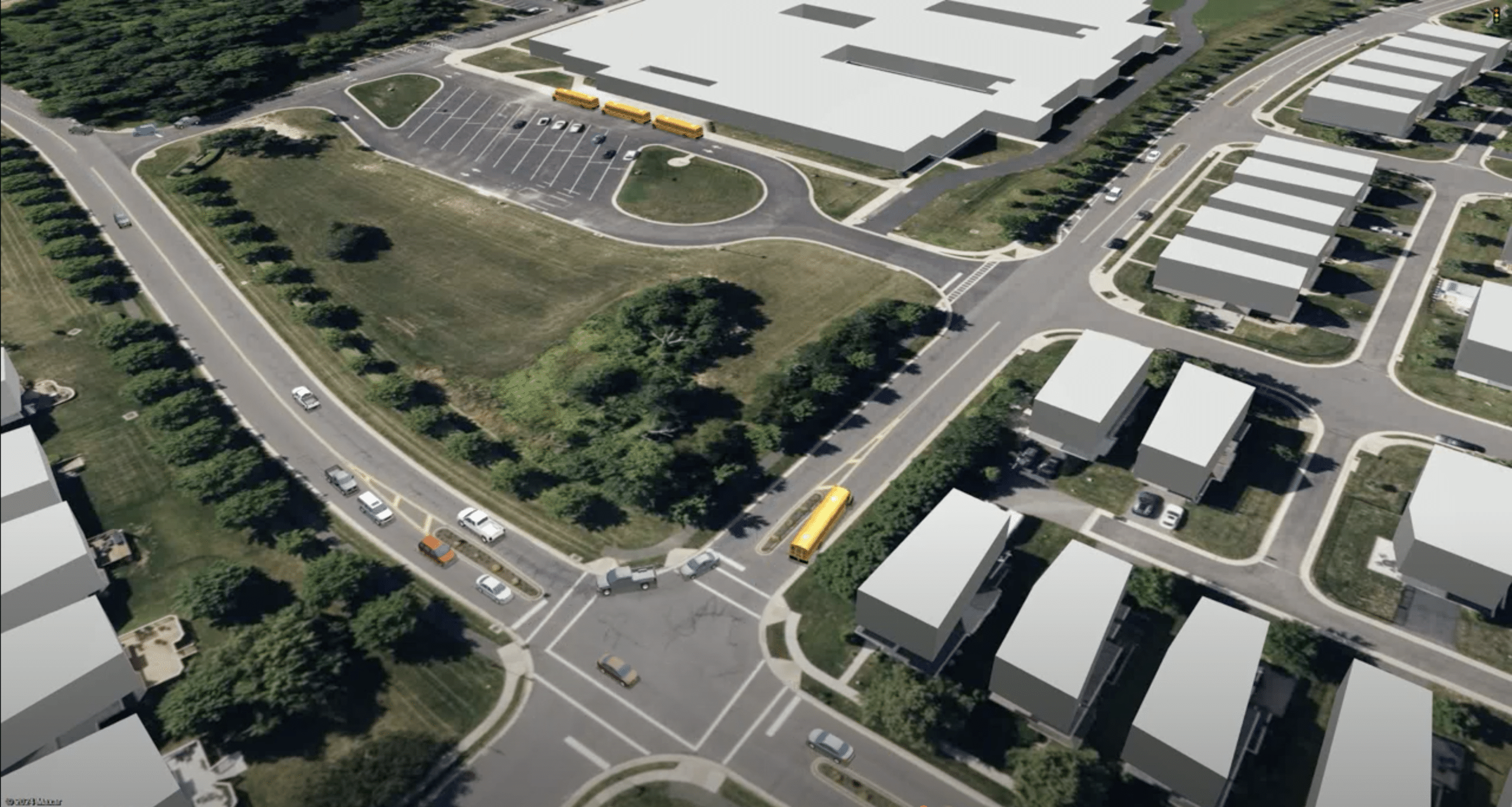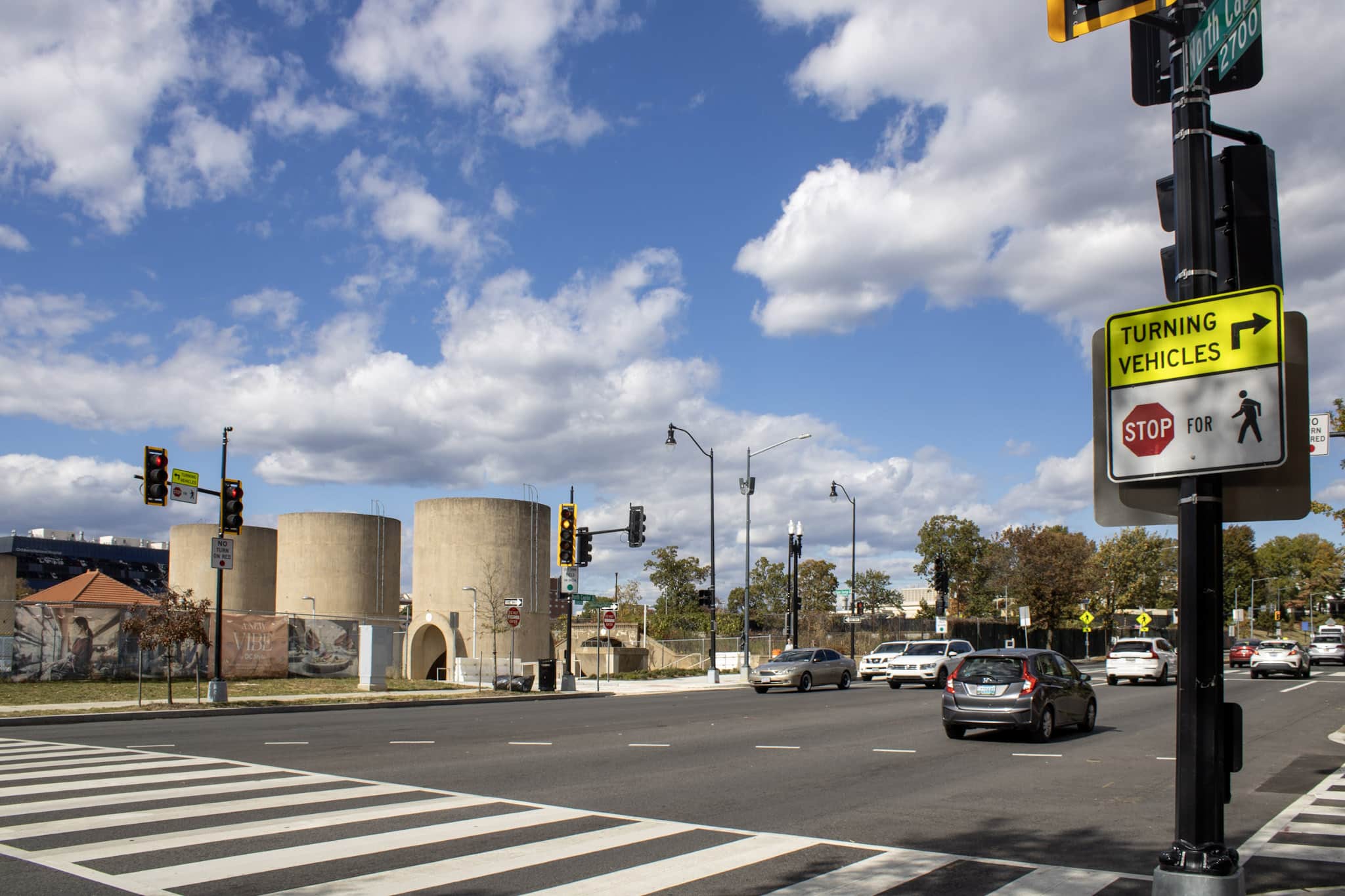
Transportation Modeling and Advanced Analysis: Moving Beyond Traditional Methods
Transportation modeling has progressed from basic traffic counts and forecasts to advanced simulations considering multiple modes, complex behaviors, and dynamic conditions. The shift toward multimodal modeling reflects our evolving transportation priorities. Today’s models must consider not only vehicles but also transit riders, cyclists, pedestrians, and emerging mobility options. This comprehensive approach ensures that transportation systems serve all users equitably while maximizing efficiency.
This Insight highlights three case studies demonstrating how Gorove Slade’s Advanced Analysis team utilizes VISSIM to develop solutions.
VISSIM: Microsimulation at Its Most Powerful
VISSIM stands out as a leading microsimulation tool when transportation challenges require detailed analysis and insights. We’ve previously addressed some common questions our team receives about VISSIM, so now it’s time to take a deeper dive.
VISSIM shines in these scenarios:
- Multimodal analysis of vehicles, transit, bicycles, and pedestrians, and their influence on each other
- Detailed and custom performance metrics by mode, time , or subarea
- Realistic visualizations of proposed designs and operations
- Analysis of unconventional and unique transportation network geometries
- Evaluation of transit priority systems and dedicated transit facilities
- The following case studies demonstrate VISSIM’s utility.
Case Study: Duke Street In Motion
Our work on Alexandria’s Duke Street In Motion project showcases the effectiveness of advanced modeling in practice. This initiative focused on implementing high-capacity transit improvements along the Duke Street corridor between the West End and the King Street Metro station.
For this project, we developed comprehensive VISSIM models covering over 50 intersections to evaluate various Bus Rapid Transit (BRT) alternatives, including:
- Buses operating in mixed traffic
- Dedicated curb-running bus lanes
- Center-running transit lanes with specialized signal operations
- Implementation of transit signal priority
There are three reasons VISSIM was the perfect tool for this project, starting with its detailed granularity, which allowed the team to model dedicated transit lanes and priority systems. Next, we replicated urban multimodal conditions to evaluate the conflicts and influences each mode had on the others. The addition of BRT necessitated adjustments to signal timings that impacted passenger car traffic on Duke Street, side streets, and the pedestrian experience when walking along and across Duke Street. All these ripple effects can be assessed and modified, so our modelers worked closely with the project design team to refine concepts with each model run.
Finally, VISSIM provided us with customized and detailed performance metrics. Thorough stakeholder coordination identified the project’s main priorities, which were communicated to Gorove Slade’s modeling team, allowing us to extract detailed metrics from VISSIM for sharing with stakeholders. The metrics included bus travel times, transit reliability, and pedestrian crossing times. These outputs gave City staff critical data to select the preferred alternative and make informed decisions regarding intersection configurations and signal operations.
Case Study: I-395/Duke Street Interchange
The redevelopment of Landmark Mall, also known as WestEnd, requires modifications to a nearby interchange to ensure safe and efficient access to the new hospital anchoring the project. Gorove Slade utilized VISSIM to model the proposed changes and ultimately secure approvals from VDOT via the Interchange Access Report/Operational and Safety Analysis Report (IAR/OSAR) process.
This project illustrates VISSIM’s ability to handle complex geometries and operations. Typically, models and tools used by transportation engineers are designed for either highways or arterial roads. Consequently, when a complicated traffic signal is proposed at the end of an interchange ramp, VISSIM’s capacity to model both effectively becomes essential for thorough analysis.
The microsimulation allowed us to:
- Document the exact interactions between merging vehicles.
- Account for speed and driver behavior differences across facility types.
- Assess adjustments to ramp configurations and signal timing.
- Analyze queue formation and dispersal in detail.
Case Study: Shared Use Trail Crossing
One of VISSIM’s strengths is its ability to place different modes on equal footing. For instance, the behaviors of pedestrians and bicyclists are just as customizable as those of personal vehicles. This enables micro-scale modeling down to the level of each individual person on the network, regardless of mode. We leveraged this capability for a trail-crossing project.
VISSIM was the ideal tool for this due to its alignment with the project’s objectives. For one, the project team was interested in determining the preferred traffic control devices to install at the intersection that (1) optimized the experience for trail users, (2) promoted safety for everyone, and (3) did not adversely affect vehicular traffic flow. In the context of these objectives, VISSIM was well-suited for evaluating and quantifying the anticipated experience of trail users. Gorove Slade’s team successfully calibrated the observed behavior of pedestrians and cyclists in the models to match those observed in the field. This included accurately replicating passing maneuvers, queuing at intersections, and response times to signal indications.
After modeling, average pedestrian crossing times, waiting times, and total travel time were compared across various alternative scenarios. Ultimately, the recommended traffic control at the crossing location was a traffic signal with timings designed to balance the needs of all travelers across all modes.
Case Study: School Pick-up/Drop-off Operations
Finally, while VISSIM is primarily used for large projects, its advantages also make it an excellent choice for smaller ones. A notable example is Gorove Slade’s simulation of pick-up and drop-off (PUDO) operations at Loudoun County Schools.
Only VISSIM can accurately model the complex aspects of a school’s pick-up and drop-off process, including the average time it takes a student to get in or out of a car, the number of vehicles that can load or unload simultaneously, the arrangement and shape of car queues, and how traffic on nearby roads influence the circulation of cars within the PUDO area, and vice versa.
VISSIM was the preferred tool for this exercise for several reasons. It allowed us to establish specific parameters, such as dwell time in the PUDO area and estimated occupancy, for each vehicle type. We were able to use timetables to designate specific arrival and departure times for school buses based on their individual schedules. The microsimulation models provided enhanced flexibility, enabling us to accurately replicate observed, on-site conditions. Additionally, our team utilized VISSIM’s visualization capabilities to produce fly-over videos of various school bus schedules and school bell time scenarios, effectively demonstrating the impact of each on students, parents, and school staff.
Why Choose Gorove Slade’s Advanced Analysis Services?
Transportation challenges rarely conform to standard templates. When complex problems demand sophisticated solutions, our Advanced Analysis team delivers with:
- Diverse technical expertise across multiple modeling platforms
- Ongoing professional development and methodology refinement
- Active participation in local and national industry groups
- Experience applying advanced tools in unique, urban, and multi-modal environments
In addition to VISSIM, our Advanced Analyses team also employs various other sophisticated analytical tools, including:
- SimTraffic: For corridor-level microsimulation with streamlined implementation
- CUBE: Travel demand modeling to assess regional impacts and long-term behavioral changes
- Predictive Safety Analysis: Tools like the Interchange Safety Analysis Tool Enhanced (ISATe), Highway Safety Software (HSS), and Interactive Highway Safety Design Model (IHSDM) quantify safety benefits of specific roadway improvements
- GIS: For data processing and analysis and visual presentation of spatial information
By leveraging these powerful analytical tools, we help clients move beyond traditional methods to develop transportation solutions that truly work for all users.
Would you like to learn more about how advanced transportation modeling could benefit your project? Contact our Advanced Analysis team today.
